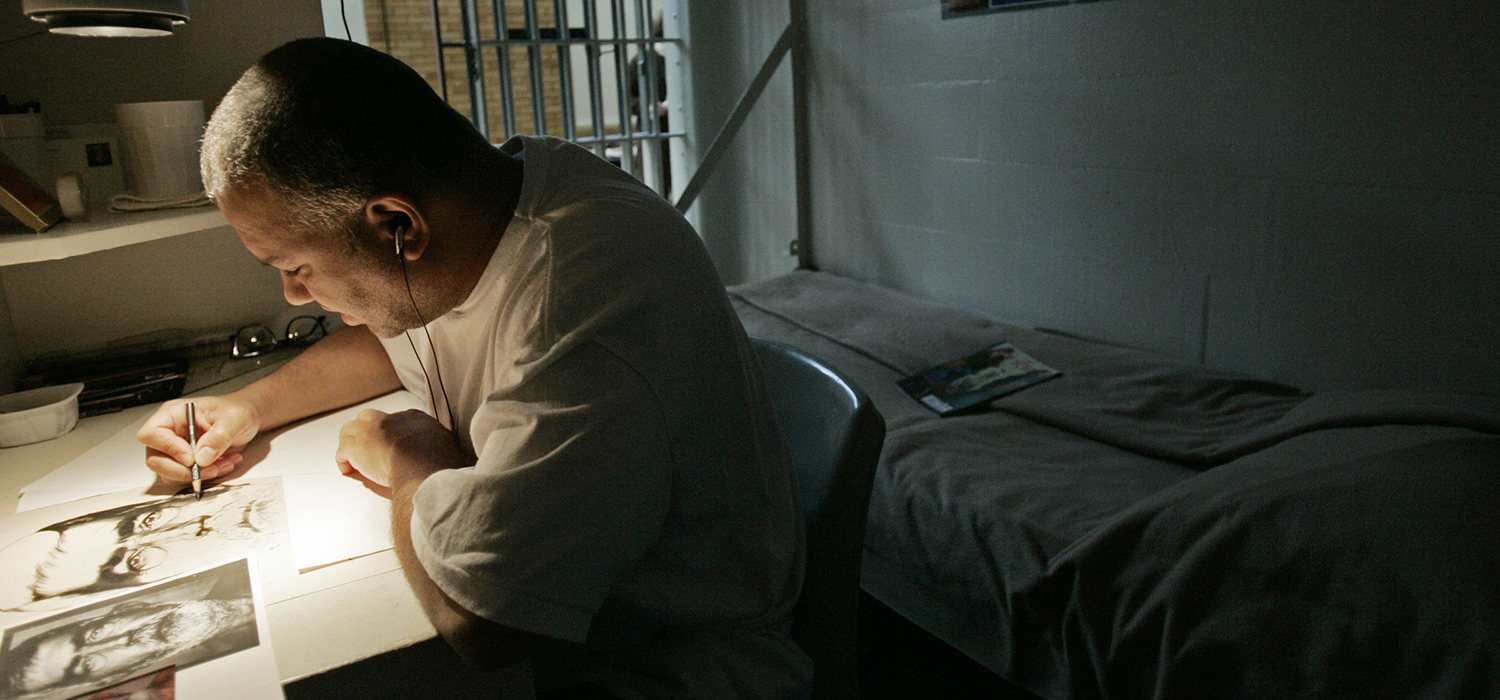
<p>Carl Wesley, an inmate at Stillwater correctional facility in Minnesota, works on artwork from his cell. Wesley is among about 40 inmates taking part in a new reading and book art program that promotes literacy and parenting skills. Photo by JERRY HOLT/Star Tribune via Getty Images.</p>
We recently announced the five states that will join the first phase of our Prison Research and Innovation Network, a community of practice for states interested in leveraging research, data, and evidence to inspire improvements in prison environments.
This project’s animating idea is to use research to shine a much-needed light on prison conditions and pilot strategies to promote the well-being of people who live and work behind bars. There are no quick fixes to ensure respect for the human rights and dignity of all people in prison, but research and data can support accountability and chart a path forward.
At the Roundtable on Prison Research and Innovation, criminal justice expert Michele Deitch presented a framework used as a test of a “healthy” prison. The framework identifies four dimensions of humane corrections institutions: safety, respect, purposeful activity, and preparedness for reentry.
With nearly 1.5 million people currently incarcerated in US prisons and more than 200,000 people working in them, how can we measure and improve these components of a healthy system? And what role might research play in making prisons safe, humane, and rehabilitative institutions for as long they exist?
Documenting the current health status of prisons
The roundtable focused on how research and greater data transparency can help ensure the dignity and humane treatment of incarcerated people. But first, participants spent some time listing the dynamics that make prisons unhealthy for both incarcerated people and those who work there.
Ronald Day, vice president of programs at the Fortune Society, was incarcerated for 15 years in seven New York facilities. He noted that despite a recent reduction in the state’s prison population, “there is still significant violence and dehumanization happening inside the facilities.”
“We would think with fewer people there might be fewer incidents, but it doesn’t necessarily translate that way,” added Day.
Evan Misshula, associate director of research at the independent Correctional Association of New York, described data collection efforts the state has undertaken to understand more about prison conditions. “The talk around respecting prisoners and their human dignity is so far from the reality of prison that I almost can’t wrap my head around it,” he said.
Elevating experiences of staff
The discussion also elevated correctional staff experiences, surfacing the challenges in promoting healthy institutions from the perspective of people working behind bars. Research shows stress levels are higher, and subsequent health outcomes, such as cardiovascular disease, are more prevalent among people working in prisons than in the general population.
Scott Semple, former commissioner of the Connecticut Department of Corrections, noted that people working in corrections sincerely want to positively impact people’s lives, yet many become jaded because they “never get to see success.” All staff see are people who enter prison and those who leave prison only to return; rarely, if ever, do they see those who depict what successful reintegration looks like.
In addition to such compassion fatigue, roundtable participants noted that corrections officers and other staff are undervalued by society at large, often don’t feel their expertise is recognized and respected, and work in systems that are consistently understaffed.
The importance of establishing a respectful, inclusive, and equitable climate came to the forefront, as did the problem of a culture that places incarcerated people and prison staff in opposition to one another.
“The [correctional officers and staff] receive training that sets up an ‘us versus them’ paradigm, which creates that power dynamic,” said Michelle Jones, a doctoral student and board chair of Constructing Our Future.
From his experience spending a total of three years in solitary confinement in New York state prisons, Johnny Perez, director of the US Prisons Program for the National Religious Campaign Against Torture, believes the key to “addressing the culture is through relationships.” But in his experience, prisons don’t create enough space for these connections to happen.
Models for more humane prisons
Examples of such spaces exist in European models of “normalization”—making life in prison as much like life anywhere else in the community as possible, and these models are beginning to be applied in the US. One example is an initiative from MILPA and the Vera Institute of Justice called Restoring Promise, which works to “transform the culture, climate, rhythms and routines that define the prison system” in prisons and jails in Connecticut, Massachusetts, and South Carolina.
These new ways of thinking about prison communities emphasize the importance of elevating the voices and experiences of the people who live and work in prisons to promote meaningful and lasting change. It also requires reckoning with the egregious racial disparities that exist in the current carceral state.
Doing so requires standardized and publicly disseminated data about what’s happening in prisons— data that can depict both the very serious problems and abuses occurring in our nation’s prisons and the effects of innovative practices already being advanced by reformers in the field.
Let’s build a future where everyone, everywhere has the opportunity and power to thrive
Urban is more determined than ever to partner with changemakers to unlock opportunities that give people across the country a fair shot at reaching their fullest potential. Invest in Urban to power this type of work.